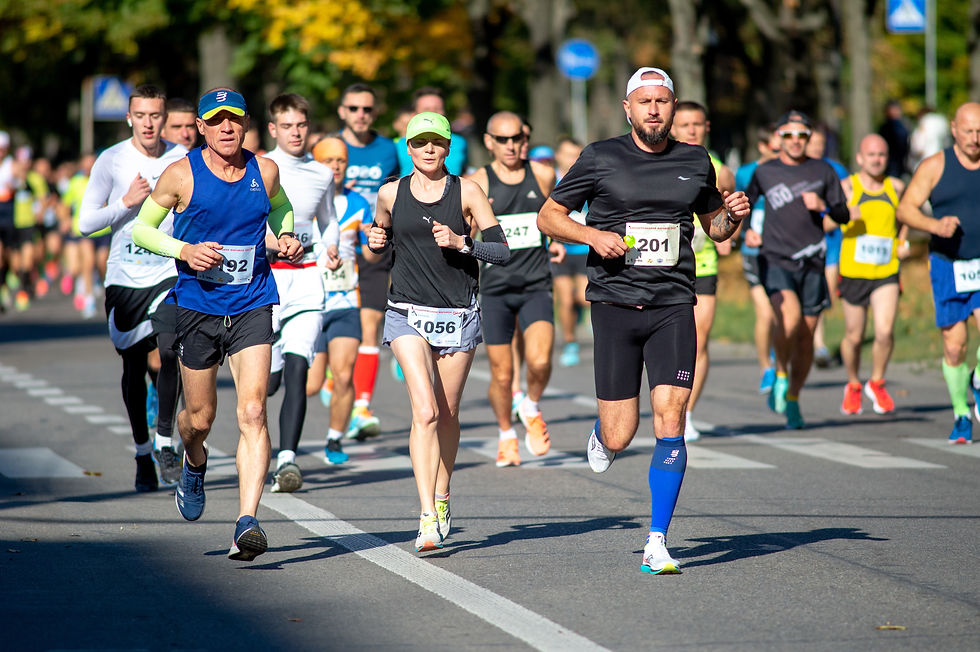The biggest mistake most runners make
- Jonathan Brown
- Apr 29, 2024
- 4 min read

Training methods have moved on tremendously over the decades. Running is no exception. Long distance running (and certainly cycling as well) have probably seen the greatest advances in training methods, nutrition and recovery methods over the last 50 years. Elite athletes are generally surrounded by a team of professionals that can guide them on every detail regarding their performance. Outside of the elite, the biggest mistake that most runners make all the time that hinders their performance abilities; they stay in their lane and don’t do any strength/resistance training.
You see this all the time in the world of exercise; strength athletes do little cardio and cardio athletes do little strength training. When in reality, both sets of athletes need to adopt some of the methods that the other possesses. And if they did, they would see their performance rates increase and their injury rates decrease.
We see this regularly in clinic when an amateur runner gets injured during their training for a half or full marathon. As their volume of training increases, so does the likelihood of injury. Sometimes pain or injuries are down to inefficient gait and hyper sensitisation of certain areas, or increases in inflammation of joints/tendons. Oftentimes, behind many of these types of pain/injury scenarios is a lack of resilience to their bodies in response to the stress they are putting them under. In clinic we are sometimes able to rectify this quite quickly if this is down to gait changes, burnout or lack of recovery/nutrition. Other times it runs a little deeper and requires a little more targeted work on the part of the individual that should come in the form of resistance training.

There are some common misconceptions and barriers that a lot of runners have regarding doing resistance training. Some are completely oblivious to the fact that working on strength and strength endurance can drastically improve performance and reduce injury rates. Others are just unsure as to what to actually do. Running is easy; trainers on, out the door and off your go. Managing a resistance training program of exercises, reps, tempo’s, weights and rest periods can for some be a really daunting place and therefore they just ignore it. And lets be honest, for new individuals who haven’t ever done strength training, the gym can be a pretty intimidating place. At the heart of it all is our fear of looking like a fool and doing it all wrong, or looking weak in front of others. And there is nothing wrong in feeling like that. Every single person that ever went to the gym for the first time or started a new sport had these fears as well. This is where working with a coach who can program the workouts or a trainer who can be there with you to guide you through the process can be useful.
We know its useful and scary to start so why should you go outside your comfort zone and start it? What are the benefits to your running?
The benefits are vast and can have HUGE implications for performance:
Targeted training helps to increase the strength and overall resilience of ligaments and tendons and ultimately the joints in the body. These are the most injured areas in runners as volume/intensity of running workouts increase. Strengthening the ligaments and tendons protects joints and improves the longevity of an athletes running season and overall lifespan of running career. Having a more robustly (think stronger not bulkier) built body will help you avoid burnout or fatigue.
Resistance training specifically targets fast twitch, type 2 muscle fibres. Training these muscle fibre types help give runners a finishing kick or burst of tactical speed in a race. Although running at low intensities or slower speeds should be a foundational component of every runners training, doing this exclusively hinders their ability to maintain a faster pace when they need or want it.
Runners who train this also give themselves a leg up when it comes to hilly sections of a race. This is because it takes more power on each step to propel yourself up a hill. The same applies to downhill sections of a race as leg muscles fatigue quicker when having to slow you down when running downhill. Having that strength endurance pays huge dividends if you are able to prevent your quads and knee extensors from blowing out when dealing with a longer downhill section.
Resistance training also uses glycolysis as the main energy system to fuel the type 2 muscle fibres. In short, this is when your body uses glucose as the primary fuel source with one of the end products being lactic acid. Training these muscle fibre types allows your body to adapt to using this energy system and clearing the byproducts. Like all things in life, the more you expose your body to a particular stimulus, the better it adapts to it. Speed/sprint based workouts do apply this stimulus to the body BUT to maximise power and endurance potential, they are not enough. Having a body that can very quickly and efficiently adapt to increased requirements of speed or power will definitely result in improved performance.
Building the complete package of training, both the slow twitch (fat as primary fuel source) and fast twitch (glucose as primary fuel source) through both sprint based and resistance training based workouts is what those who want to maximise their potential should consider applying.
Remember, don’t just stay in your lane. Runners who just run, will be out run by those who apply a broad range of training types.
To work with me, please fill in the contact form and we can discuss your performance and how you can optimise it to achieve new personal bests.




Comments